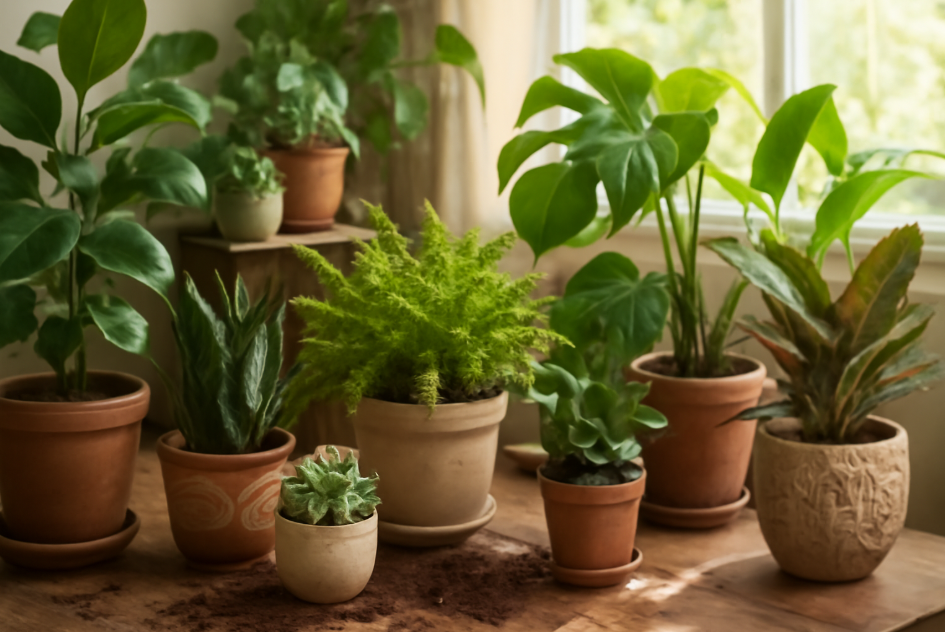
10 Easy Indoor Plant Potting Mix Recipes for Healthy, Thriving Plants
Are your indoor plants struggling to thrive despite your best efforts? 
But with so many options available, it’s easy to feel overwhelmed. Should you buy pre-made mixes, or can you create your own? The good news is, making your own potting mix is not only cost-effective but also allows you to tailor it to each plant’s unique needs. In this guide, we’ll walk you through 10 easy indoor plant potting mix recipes designed to help your plants flourish. From succulents to tropicals, you’ll find the perfect mix to suit every type of indoor greenery. Keep reading to unlock the secret to healthier, happier plants!
Table of Contents
ToggleKey Ingredients in Potting Mixes for Indoor Plants
The right potting mix is essential for indoor plant health. The good news? You don’t need to be a gardening expert to create the perfect soil blend. Understanding the key ingredients in potting mixes will help you create customized mixes that are perfectly suited to your plant’s needs. Let’s break down the most important components.
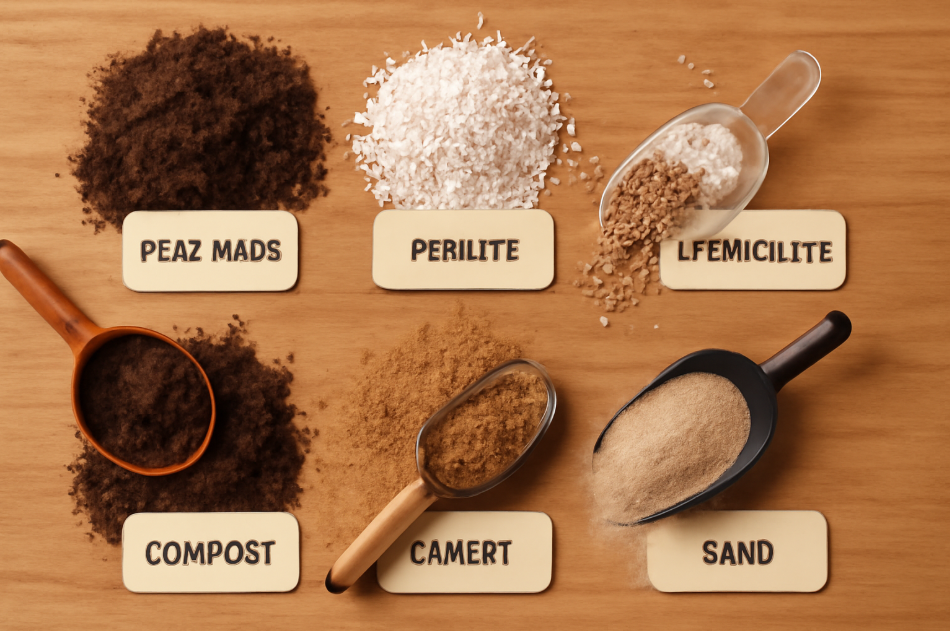
1. Peat Moss
Peat moss is one of the most common ingredients in potting mixes. It helps retain moisture and provides a soft, airy texture to the mix. While it’s excellent for moisture retention, it can make the soil slightly acidic. 
2. Coconut Coir
A sustainable alternative to peat moss, coconut coir retains moisture while providing excellent drainage. It’s a great choice for those looking for an eco-friendly option. Plus, it’s pH-neutral, making it safe for most plants. 
3. Perlite
Perlite is a volcanic rock that’s heated to create lightweight, white pellets. It’s added to potting mixes to improve drainage and aeration. By increasing air pockets in the soil, it ensures that roots have the oxygen they need to thrive. 
4. Vermiculite
Vermiculite is similar to perlite but has the added benefit of improving moisture retention. It’s a mineral that expands when heated, creating a sponge-like structure. This helps your plants retain water without the soil becoming soggy. 
5. Compost
Compost is packed with nutrients that will keep your plants healthy and strong. It helps create a rich, fertile environment for your plants’ roots. Using homemade or store-bought compost can give your soil a nutrient boost. 
6. Sand
Sand is used to increase drainage and prevent soil from becoming too compact. It’s an especially helpful addition to mixes for succulents and cacti, where fast drainage is key. 
7. Worm Castings
Worm castings are nature’s fertilizer! They add beneficial microbes to the soil and help break down organic matter, promoting root health and nutrient absorption. 
How to Use These Ingredients Together
Now that you understand the key components, mixing them in the right proportions is key to a successful potting mix. The balance will depend on the needs of your specific plants—whether they require more moisture, better drainage, or extra nutrients. 
10 Easy Indoor Plant Potting Mix Recipes for Different Plant Types
Creating the perfect potting mix can seem tricky, but once you understand your plant’s needs, it’s easy to craft a blend that will help them thrive. Below are 10 easy indoor plant potting mix recipes, each designed to suit different types of plants. Whether you’re caring for succulents, tropicals, or orchids, there’s a mix here for you!
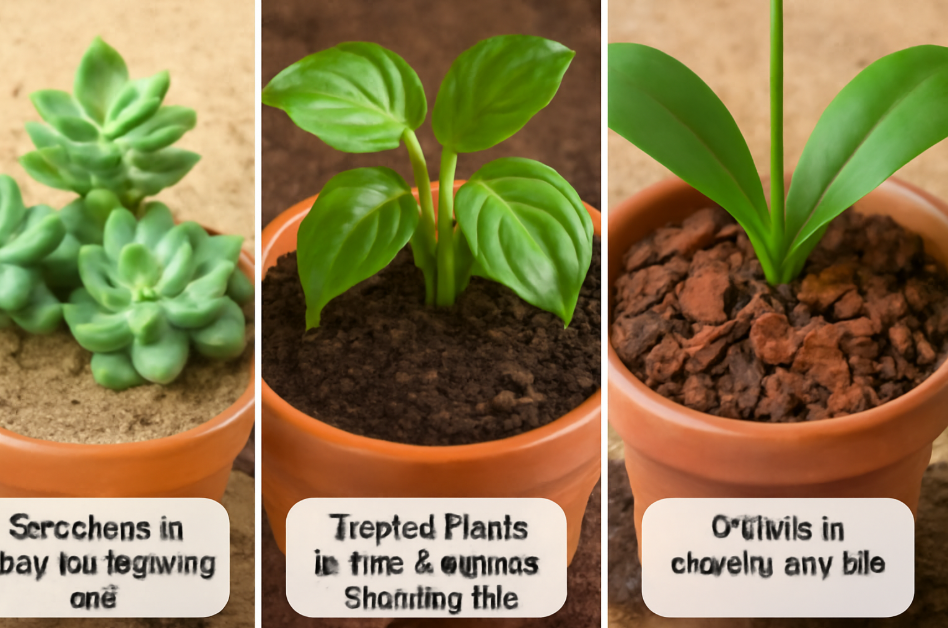
1. All-Purpose Potting Mix
Best For: Most indoor plants (e.g., ferns, peace lilies, pothos).
This simple, versatile mix works for many plants and provides a good balance of moisture retention and drainage.
- Recipe:
- 2 parts peat moss
- 1 part perlite
- 1 part compost
- Benefits: Great for general plant care, retains moisture but drains well.
2. Cactus and Succulent Potting Mix
Best For: Cacti, succulents, aloe, jade plants.
Succulents need well-draining soil to prevent root rot. This mix ensures water doesn’t linger around the roots.
- Recipe:
- 3 parts coarse sand
- 2 parts perlite
- 1 part peat moss
- Benefits: Fast drainage, mimics the desert environment succulents love.
3. Tropical Plant Potting Mix
Best For: Tropical plants like philodendrons, ferns, and monstera.
Tropical plants need a soil mix that retains moisture while still allowing air to reach their roots.
- Recipe:
- 2 parts peat moss
- 1 part coconut coir
- 1 part perlite
- Benefits: Keeps the mix moist and airy, perfect for humidity-loving plants.
4. Orchid Potting Mix
Best For: Orchids.
Orchids require a chunky, well-draining mix to thrive. They don’t like sitting in wet soil, so this mix provides plenty of airflow to the roots.
- Recipe:
- 1 part orchid bark
- 1 part perlite
- 1 part sphagnum moss
- Benefits: Great air circulation around roots, mimics the orchid’s natural growing conditions.
5. Fern Potting Mix
Best For: Ferns (e.g., Boston ferns, bird’s nest ferns).
Ferns like consistently moist, but well-drained soil. This mix retains enough moisture to keep your ferns happy without becoming soggy.
- Recipe:
- 2 parts coconut coir
- 1 part perlite
- 1 part compost
- Benefits: Keeps the soil moist but allows excess water to drain.
6. Vegetable Garden Indoor Mix
Best For: Indoor vegetable plants (e.g., tomatoes, herbs, peppers).
Vegetables need a nutrient-rich soil mix that still drains well, to promote strong root growth.
- Recipe:
- 2 parts compost
- 1 part peat moss
- 1 part perlite
- 1 part vermiculite
- Benefits: Nutrient-rich with great drainage, perfect for growing indoor veggies.
7. African Violet Potting Mix
Best For: African violets.
These delicate plants need a soil mix that holds moisture but doesn’t become waterlogged.
- Recipe:
- 2 parts peat moss
- 1 part perlite
- 1 part vermiculite
- Benefits: Perfect for keeping the soil moist but well-drained for these sensitive plants.
8. Cactus Potting Mix with Extra Drainage
Best For: Cacti and other dry-loving plants.
For a super-draining mix, this recipe is ideal for plants that need to dry out quickly.
- Recipe:
- 4 parts coarse sand
- 1 part perlite
- 1 part peat moss
- Benefits: Provides maximum drainage to prevent water retention and root rot.
9. Succulent Soil Mix with Charcoal
Best For: Succulents and other drought-tolerant plants.
Adding charcoal helps absorb excess moisture and odors, keeping the soil fresh and well-drained.
- Recipe:
- 3 parts pumice
- 1 part perlite
- 1 part charcoal
- Benefits: Extra drainage with odor control for healthy, thriving succulents.
10. Bonsai Soil Mix
Best For: Bonsai trees.
Bonsai trees require a mix that promotes root growth while draining well. This blend allows for both proper aeration and moisture retention.
- Recipe:
- 1 part akadama (a clay-based soil)
- 1 part pumice
- 1 part lava rock
- Benefits: Provides excellent aeration and ensures the right balance of moisture.
How to Use These Recipes
Each of these recipes is designed with a specific plant in mind. Use the correct one for your plant type to ensure the best results! 
How to Mix and Prepare Potting Soil for Indoor Plants
Now that you have your indoor plant potting mix recipes ready, it’s time to get mixing! Preparing the right potting mix for your indoor plants doesn’t have to be complicated. Follow these simple steps, and you’ll have the perfect soil blend in no time.
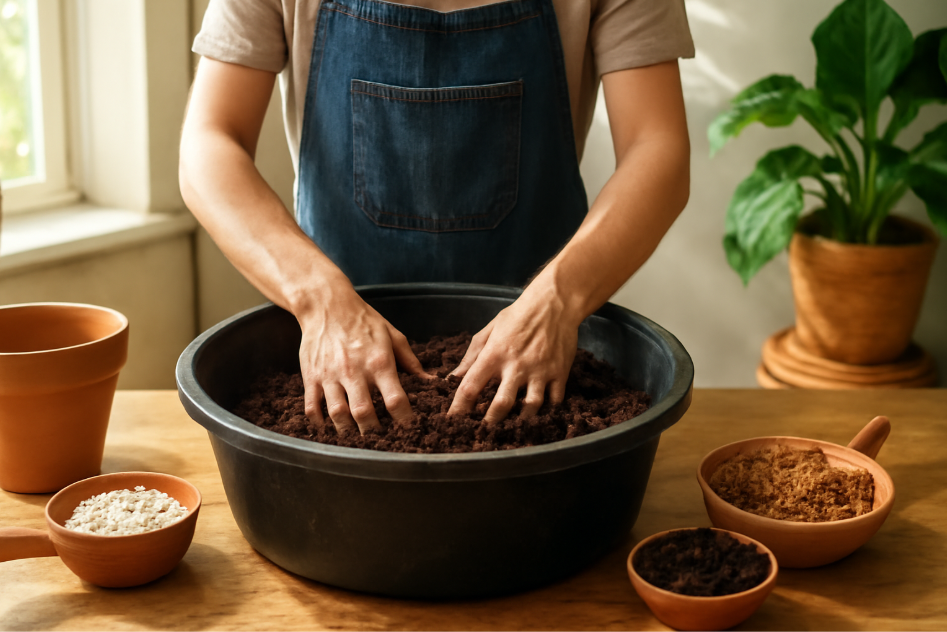
Step 1: Gather Your Ingredients
Before you start mixing, make sure you have all your ingredients ready. You’ll need your base components (e.g., peat moss, coconut coir), drainage enhancers (e.g., perlite, sand), and any extra ingredients like compost or worm castings. It’s helpful to have everything measured out ahead of time to avoid interruptions.
Step 2: Choose the Right Mixing Container
Pick a large container or mixing tub that’s easy to work with. It should be big enough to comfortably mix your ingredients without spilling. A plastic bin or a sturdy bucket works great. If you’re making multiple batches, a large wheelbarrow can also do the trick!
Step 3: Mix the Dry Ingredients First
Start by combining the dry ingredients, such as peat moss, perlite, and compost. Use a shovel, rake, or your hands (wear gloves for protection) to thoroughly mix the ingredients. This helps ensure that the components are evenly distributed, which is key to getting a balanced potting mix.
- Tip: If you’re using ingredients like sand or perlite, be sure to break up any large clumps to avoid uneven texture.
Step 4: Moisten the Mix
After you’ve mixed the dry ingredients, it’s time to add moisture. The goal is to make the mix slightly damp—not soaking wet. Lightly mist the soil with water and stir until it’s evenly moist. This helps the ingredients bind together and improves the texture. If the mix feels too dry, add more water, a little at a time, until it feels like a damp sponge.
- Tip: If you’re mixing soil for a plant that requires more moisture retention, you might want to add extra coconut coir or vermiculite at this stage to enhance the mix.
Step 5: Check the Consistency
Once your mix is moist, check its consistency. It should be light, airy, and well-drained. Squeeze a small handful of the mix in your hand—if it holds together but doesn’t drip water, you’ve got the right consistency. If it falls apart easily, you may need to add a bit more moisture or coconut coir.
Step 6: Optional—Sterilize Your Soil
If you’re reusing potting mix or want to make sure it’s free of pests, diseases, or weed seeds, consider sterilizing it. This can be done by baking the mix in the oven at 180°F (82°C) for about 30 minutes. It’s not necessary for all mixes, but if you want peace of mind, it’s a helpful step!
Step 7: Store Your Mix for Later Use
If you have leftover potting mix, store it in an airtight container or bag. Keep it in a cool, dry place until you’re ready to use it. This will keep the mix fresh and ready to go whenever you need it!
Quick Tips for Best Results
- Don’t Overmix: It’s important not to overwork the soil, as this can break down the structure and affect drainage.
- Adjust as Needed: If you find the mix is too heavy or too light, simply adjust the proportions. For example, adding more perlite increases drainage, while adding more peat moss improves moisture retention.
- Label Your Mixes: If you create multiple recipes, label them with the plant type they’re for. This will save you time and confusion when potting your plants!
Now that you’ve mastered how to mix and prepare your potting soil, you’re one step closer to growing healthy, thriving indoor plants!
Common Mistakes to Avoid When Potting Indoor Plants
Potting your indoor plants may seem straightforward, but a few common mistakes can set your plants back in their growth. Avoid these pitfalls to ensure your plants stay healthy and happy!
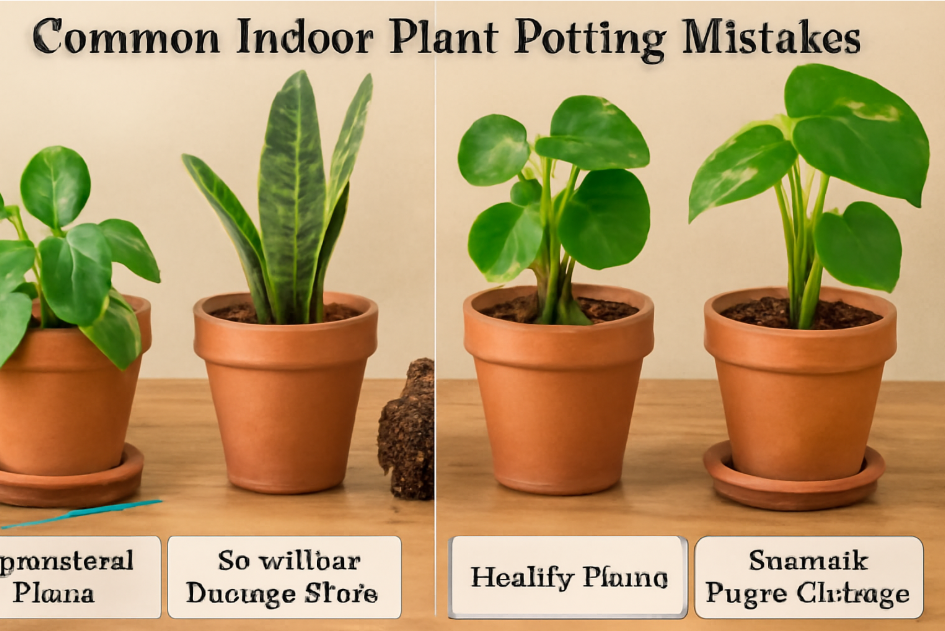
1. Using the Wrong Potting Mix
Not all potting mixes are created equal. Each plant has specific needs when it comes to soil. For example, succulents and cacti require well-draining mixes, while tropical plants need soil that retains moisture.
- Solution: Always choose or create a potting mix tailored to your plant’s specific needs. Refer back to our potting mix recipes to find the right blend for each plant type!
2. Overwatering Your Plants
Overwatering is one of the most common causes of plant stress and root rot. A heavy, poorly-draining mix or an inappropriate watering schedule can make the problem worse.
- Solution: Ensure your potting mix allows for proper drainage. Always check the moisture level before watering. If the soil feels wet, skip the watering that day!
3. Using Regular Garden Soil
Garden soil is too dense for indoor plants, and it can lead to poor root development and drainage issues. It often contains pests, weed seeds, or diseases that can harm your plants.
- Solution: Stick to using lightweight, sterile potting mixes specifically designed for indoor plants.
4. Not Repotting When Necessary
Plants outgrow their pots faster than you might think! If your plant becomes root-bound (when roots grow tightly around the edges of the pot), it can’t absorb nutrients properly.
- Solution: Check your plant’s roots every year. If you see them crowding the pot or growing through drainage holes, it’s time to repot!
5. Using a Pot Without Drainage Holes
A pot without drainage holes can trap water at the bottom, causing the roots to sit in stagnant water. This increases the risk of root rot and fungal growth.
- Solution: Always use pots with drainage holes to allow excess water to escape. If you love a decorative pot without holes, consider using it as an outer layer and placing a smaller, functional pot inside.
6. Not Adjusting Your Mix for Seasonal Changes
Indoor plants’ watering and moisture needs can change with the seasons. A mix that works in the summer may not be suitable in winter when your plants are dormant.
- Solution: Adjust your potting mix as needed. In the cooler months, you may want to increase moisture-retaining ingredients like coconut coir, especially for tropical plants.
7. Not Sterilizing Your Potting Mix (When Needed)
If you’re reusing potting mix or using homemade compost, it may contain pests, diseases, or mold spores that can harm your plants.
- Solution: Sterilize the mix by baking it in the oven at 180°F (82°C) for 30 minutes to kill any harmful organisms.
8. Using Too Much Fertilizer
While fertilizer is important, too much can damage your plant’s roots and stunt growth. Excessive nutrients can also build up in the soil, leading to nutrient imbalances.
- Solution: Use slow-release fertilizers or diluted liquid fertilizers, and follow the manufacturer’s recommended amounts. Always test the soil before adding more!
Quick Tips for Success
- Proper Drainage Is Key: Always check that your pot has drainage holes, and your mix isn’t too heavy.
- Moisture Awareness: Learn the water needs of each plant. Tropical plants need regular watering, but succulents only need water when the soil is dry.
- Repotting Timing: Don’t wait too long to repot; it’s better to move your plant to a larger pot sooner rather than later.
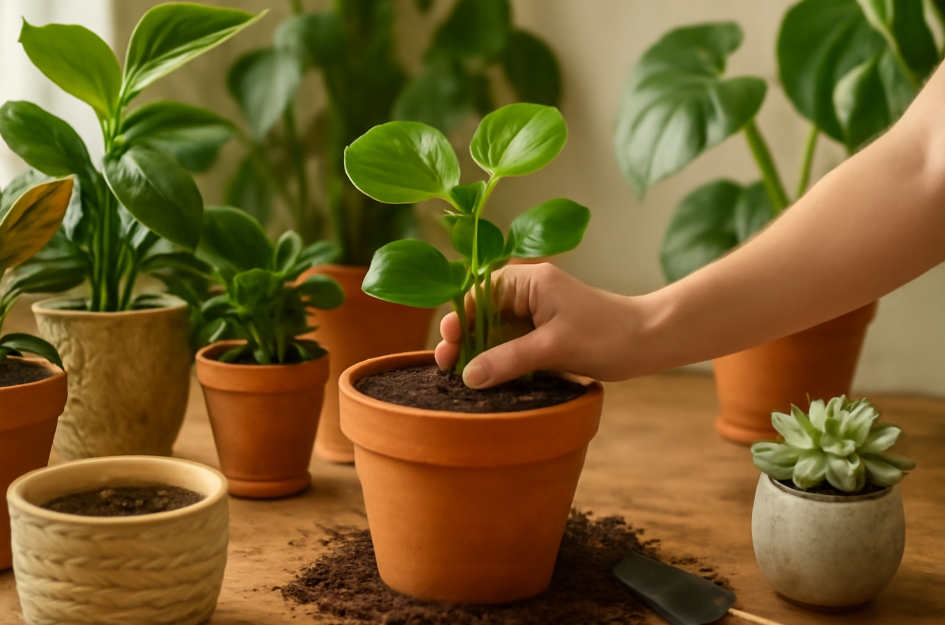
Creating the perfect potting mix for your indoor plants doesn’t have to be a daunting task. With the right ingredients and a little know-how, you can craft a custom blend that helps your plants thrive. From all-purpose mixes to recipes tailored for specific plant types like succulents, ferns, or orchids, you now have the tools to provide your plants with the ideal environment for growth.
Remember, the key to healthy indoor plants is understanding their unique needs and adjusting your potting mix accordingly. Whether it’s ensuring proper drainage, moisture retention, or nutrient balance, each ingredient plays a vital role in plant health. And don’t forget—healthy soil is just one part of the equation! Proper watering, adequate sunlight, and repotting when needed will also help keep your plants happy and strong.
We hope this guide has made it easier for you to mix and match the right ingredients for your indoor garden. 
Frequently Asked Questions (FAQs)
1. What is the best potting mix for indoor plants?
The best potting mix for indoor plants depends on the type of plant you’re growing. For general indoor use, an all-purpose mix with peat moss, perlite, and compost works well. For succulents and cacti, a well-draining mix with sand and perlite is ideal, while tropical plants need moisture-retentive mixes with coconut coir and perlite. 🌿
2. Can I make my own potting mix for indoor plants?
Yes! Making your own potting mix is easy and cost-effective. You can customize the mix to suit the specific needs of your plants. Simply combine ingredients like peat moss, perlite, coconut coir, and compost to create a well-draining and nutrient-rich soil mix. 🌱
3. How often should I change my indoor plant’s potting mix?
You should change the potting mix every 1–2 years, or when your plant becomes root-bound. If you notice your plant struggling to grow, it could be time for a fresh mix to provide better nutrients and drainage. Make sure to check the roots for signs of overcrowding or poor health. 🌟
4. What is the difference between perlite and vermiculite in potting mixes?
Perlite is a lightweight volcanic rock that improves aeration and drainage, making it ideal for plants that require well-drained soil like succulents and cacti. Vermiculite, on the other hand, holds moisture and nutrients, making it better for moisture-loving plants like ferns and tropicals. 🌿
5. Can I use garden soil for indoor plants?
It’s not recommended to use garden soil for indoor plants. Garden soil is often too dense, which can lead to poor drainage and root rot. Indoor plants thrive best with a light, airy potting mix designed for container growth. 🌸
6. How do I prevent overwatering my indoor plants?
To prevent overwatering, make sure your potting mix has good drainage. Always check the moisture level before watering—if the soil feels wet, wait a few more days. Using a pot with drainage holes is also essential for allowing excess water to escape. 💧
7. How do I know if my plant’s potting mix is too dry or too wet?
A mix that’s too dry will feel crumbly and pull away from the sides of the pot. If it’s too wet, the soil will feel soggy and might have a foul odor. Ideally, your potting mix should be evenly moist, with good air pockets to promote root health. 🌱
8. Can I add fertilizer to my potting mix?
Yes, you can add fertilizer to your potting mix, but it’s important not to overdo it. Using a slow-release fertilizer or mixing in organic compost is the best way to provide nutrients without overwhelming the plant’s roots. Be sure to follow recommended amounts to avoid nutrient burn. 🌿










